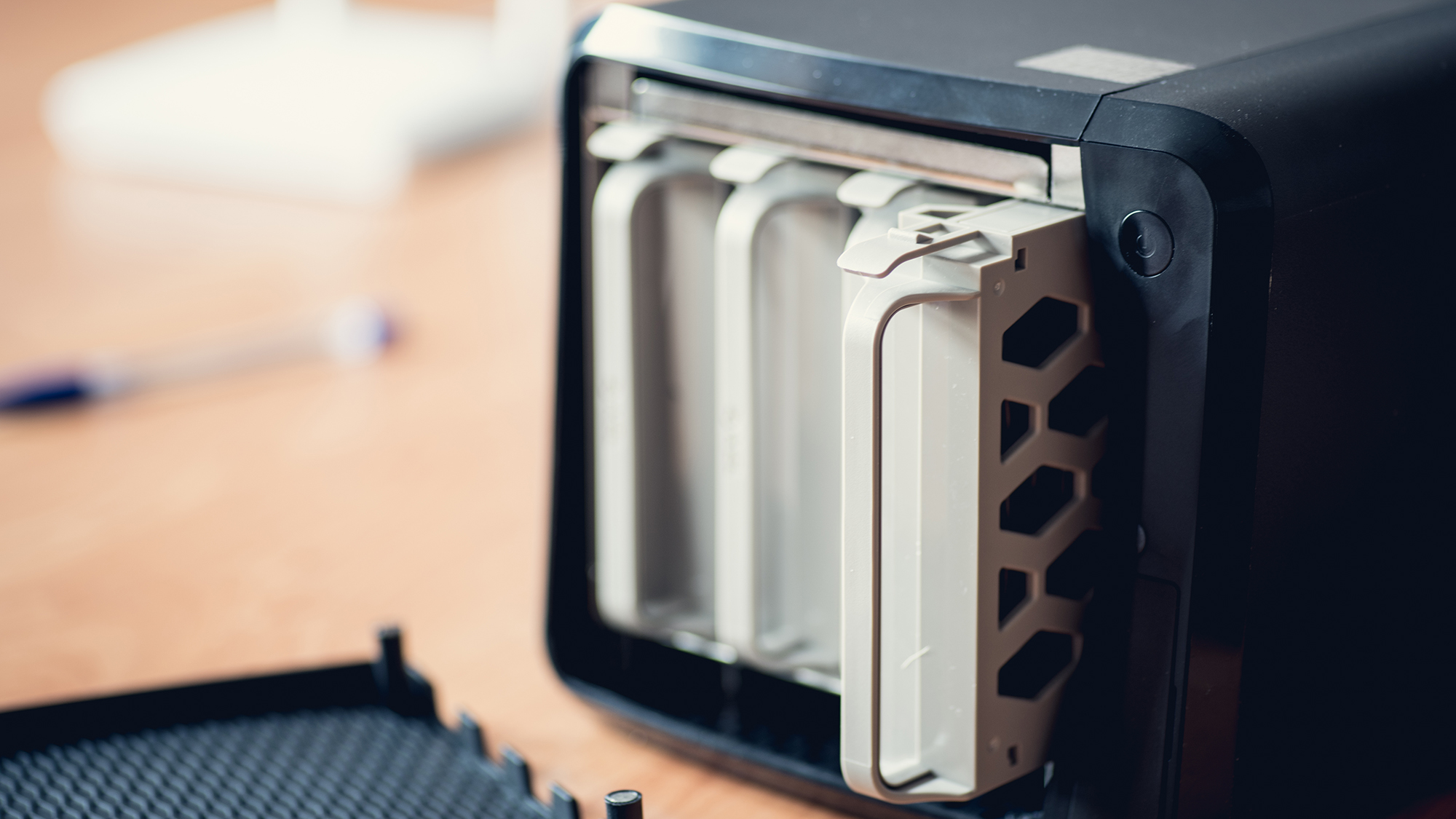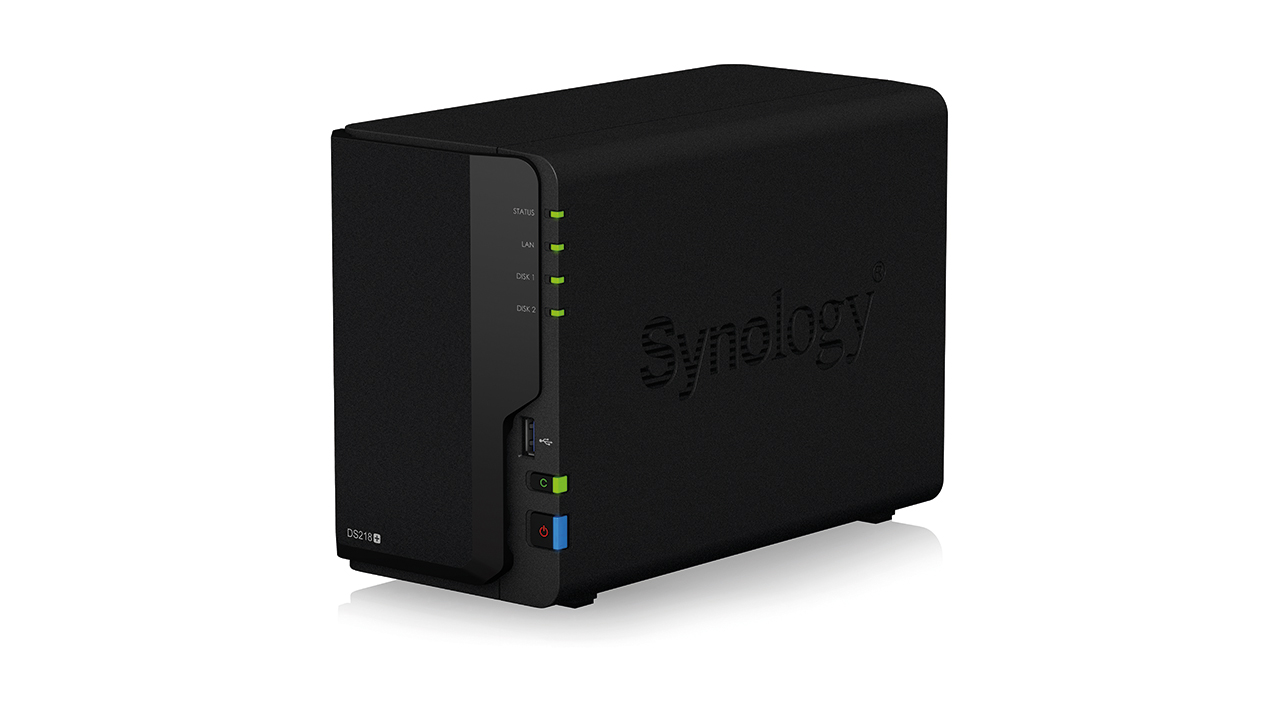Back up your files with these top NAS drives
A NAS is the one box every home and business should have. We put nine flexible devices through their paces to find a winner


The Synology DS218+ is an evolution of the DS218 that came close to scooping a Recommended award the last time we reviewed it. In fact, the physical design is virtually identical, and the differences come down to the interior spec. While the DS218 is based on a Realtek quad-core CPU, backed up by 2GB of RAM, the plus model features a dual-core Intel Celeron J3355, giving it some extra grunt. Given that performance was roughly the only thing that let the DS218 down, this is definitely a step in the right direction.
The design, as is so often the case with Synology, is smart, functional and understated. The two drive bays are concealed underneath a magnetic flap, while the drives slide out smoothly in tool-less plastic caddies, which attach via clip-on side plates rather than screws. You genuinely can remove and fit a drive within five minutes (we timed it) making populating the DS218+ a breeze. And even with the presence of a 92mm fan at the back of the chassis, the solid, rattle-free construction helps keep the Synology relatively quiet. The manufacturer claims 19.3dB in operation, and it’s certainly one of the quietest NAS drives we’ve used.
In terms of connectivity, it’s basic, with a single USB 3 port at the front for easy backups to an external HDD, along with two more USB 3 ports at the rear. There’s also an eSATA port, but while the one on the DS1019+ will support an additional Synology expansion unit, this one just supports an external drive. Moreover, as with most mainstream two-bay units, there’s just a single Gigabit Ethernet, taking any kind of link aggregation off the menu.
Synology aced easy setup long ago – to the extent that many other NAS manufacturers now follow the same basic process. You connect through a web page, which finds your NAS device, and from there it’s a matter of downloading and installing the latest DSM software before configuring the storage pool and installing your first bunch of apps.

If you can manage a Windows desktop or – better still – have some experience of a good Linux distro, there’s really nothing here that’s going to rattle you, with all the major management tools exactly where you’d expect them, easy-access dashboards for monitoring and an accessible app store for discovering and installing apps.
Synology’s own apps cover all of the basics, including file-sync, media management and streaming and backup. Yet, while it’s smaller and cheaper than the beefy DS1019+, the DS218+ can still run most of the same apps and take on a similarly wide range of tasks. Many of Synology’s apps mirror cloud services you would expect from either Microsoft or – particularly – Google, so if you want chat, synced folders, a collaborative office suite, email and even photo management and sharing, you can have it from just one small box on your local network. And if you’re more concerned about data protection, the Synology DS218+’s Btrfs file system gives you snapshotting with file or folder-level restoration.
What’s more impressive is that the DS218+ has the horsepower to run these applications for a family or a small team of people, although you might be pushing it expecting it to so for a whole office. With the enhanced spec comes much improved file transfer performance, plus additional capabilities such as on-the-fly 4K transcoding. In our tests, it was consistently amongst the top performers, both for the kind of sequential file transfer tasks you would get when copying large video files and for more complex, granular tasks such as backing up a directory full of documents and photos. The DS218+ also delivered high levels of performance while streaming 4K video, although the playback on the other end was choppy, to say the least.
Get the ITPro daily newsletter
Sign up today and you will receive a free copy of our Future Focus 2025 report - the leading guidance on AI, cybersecurity and other IT challenges as per 700+ senior executives
With the same plus points as the DS218 combined with stronger performance, it’s not hard to recommend the DS218+. For some users the Asustor AS5304T will be an even stronger choice, but it’s also more expensive – and you might not need or want its additional features. As far as mainstream, two-bay NAS goes, the DS218+ is the one to beat.
Synology DS218+ specifications
| Model number | DS218+ |
| Price (inc VAT) | £242 (£290) |
| Warranty | 2yr RTB |
| Dimensions (WDH) | 108 x 232.2 x 165mm |
| Noise level | 19.3dB |
| CPU | Intel Celeron J3355 |
| CPU cores | Dual core |
| CPU speed, cores | 2GHz to 2.5GHz |
| RAM/maximum RAM | 2GB/6GB |
| Bays (free) | 2 (2) |
| Drive type | 3.5in hard disk/2.5in hard disk |
| Max internal capacity | 32TB |
| RAID modes | SHR, JBOD, 0, 1 |
| Bay type | Slide-in caddy |
| Hot swap? | Yes |
| 2.5in drives supported | Yes |
| SSD support | No |
| Status display | 6 x status LEDs |
| Gigabit Ethernet ports | 1 |
| 10GB Ethernet ports | No |
| USB ports (rear) | 2 x USB 3 |
| USB ports (front) | USB 3 |
| Other | eSATA |
| 802.3ad link aggregation | No |
| Load balancing | Not applicable |
| Network failover | Not applicable |
| Major network protocols | SMB, NFS, FTP, SNMP, LDAP, CalDAV |
| iSCSI target | 128 |
| USB expansion options | Yes |
| NAS OS/firmware | Synology DiskStation Manager |
| Main desktop software | Synology DiskStation Manager |
| Remote access | Cloud Station Drive, Cloud Station Sharesync |
| Cloud integration | iDrive, Elephant Drive |
| Backup | Acronis TrueImage, Active Backup, Glacier Backup, Hyper Backup |
| Media | Audio Station, Video Station, Memories, iTunes Server, MinimServer, Plesk, Logitech Media Server, |
| Surveillance | Surveillance Station |
| Testing and Development | Docker, Java, Node.js, PHP, Perl, Python, Ruby, GitLab |
| Other major services | Drupal, Magento, MailPlus, Moodle, Synology Office, Virtual Machine Manager, Chat Server |
Stuart has been writing about technology for over 25 years, focusing on PC hardware, enterprise technology, education tech, cloud services and video games. Along the way he’s worked extensively with Windows, MacOS, Linux, Android and Chrome OS devices, and tested everything from laptops to laser printers, graphics cards to gaming headsets.
He’s then written about all this stuff – and more – for outlets, including PC Pro, IT Pro, Expert Reviews and The Sunday Times. He’s also written and edited books on Windows, video games and Scratch programming for younger coders. When he’s not fiddling with tech or playing games, you’ll find him working in the garden, walking, reading or watching films.
You can follow Stuart on Twitter at @SATAndrews.
-
 CISA issues warning in wake of Oracle cloud credentials leak
CISA issues warning in wake of Oracle cloud credentials leakNews The security agency has published guidance for enterprises at risk
By Ross Kelly
-
 Reports: White House mulling DeepSeek ban amid investigation
Reports: White House mulling DeepSeek ban amid investigationNews Nvidia is caught up in US-China AI battle, but Huang still visits DeepSeek in Beijing
By Nicole Kobie